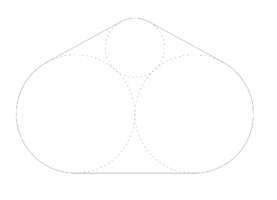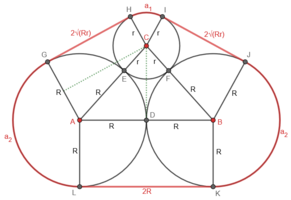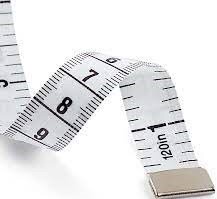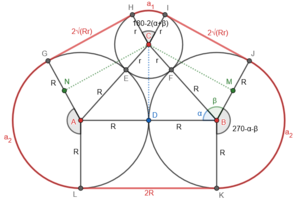Hello, I'm trying to build an equation that I can use to calculate the perimeter of a triangle with rounded corners. I'm not looking for a specific answer but an equation so I can plug different numbers in to calculate the perimeter for different sizes.
The actual issue is I'm trying to bundle 3 cables together, two larger ones horizontally and one smaller one on top. I want to find the exact length of a piece of rope or something wrapped around the entire bundle. The attached image shows this. I'm trying to calculate the perimeter of the solid line and the dashed lines are just to indicate where the cables would be. For the attached example, the cables on the bottom have a 3" radius and the top cable has a 1.5" radius.
I worked out how to find the length of the tangent lines between them using this equation and it seems to work well:
[math]L = \sqrt{{(D - (R1 + R2))^2 - (R2 - R1)^2}}[/math]
L is length of tangent line
D is the distance between the center points of the circles
R1 and R2 are circle radii
The part I am stumped on is calculating the length of the arcs between the tangent lines. I can do it if all three cables are the same size by just taking 1/3rd of the circumference but that all changes when I have multiple cable sizes.
Hope this is clear enough. Any help will be greatly appreciated. Thank you!
The actual issue is I'm trying to bundle 3 cables together, two larger ones horizontally and one smaller one on top. I want to find the exact length of a piece of rope or something wrapped around the entire bundle. The attached image shows this. I'm trying to calculate the perimeter of the solid line and the dashed lines are just to indicate where the cables would be. For the attached example, the cables on the bottom have a 3" radius and the top cable has a 1.5" radius.
I worked out how to find the length of the tangent lines between them using this equation and it seems to work well:
[math]L = \sqrt{{(D - (R1 + R2))^2 - (R2 - R1)^2}}[/math]
L is length of tangent line
D is the distance between the center points of the circles
R1 and R2 are circle radii
The part I am stumped on is calculating the length of the arcs between the tangent lines. I can do it if all three cables are the same size by just taking 1/3rd of the circumference but that all changes when I have multiple cable sizes.
Hope this is clear enough. Any help will be greatly appreciated. Thank you!




